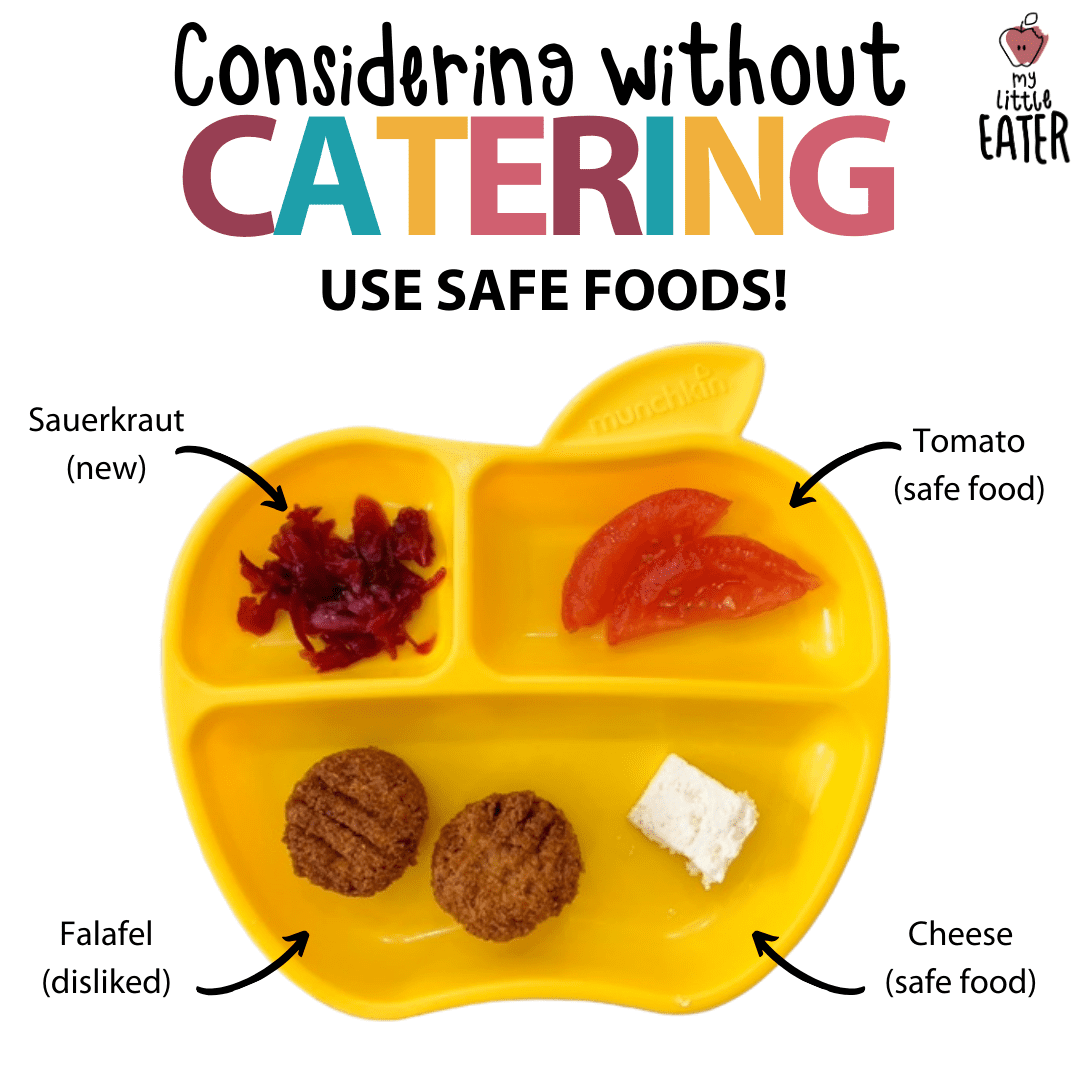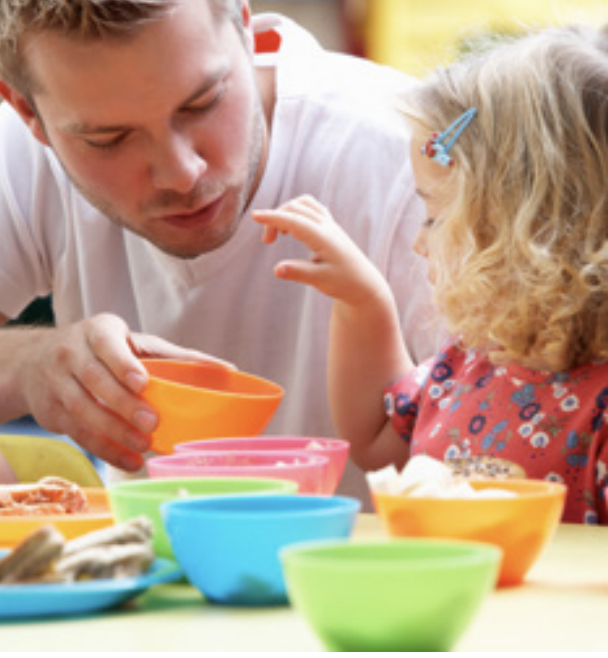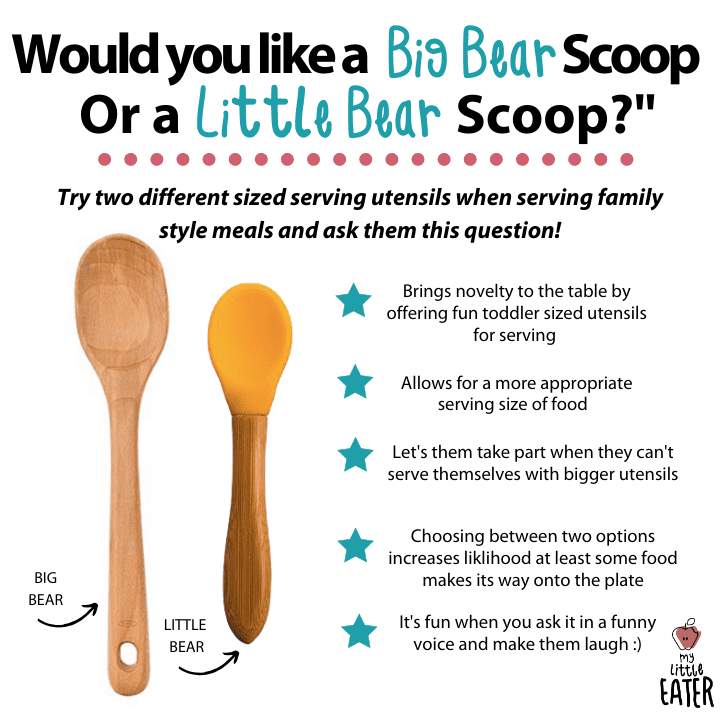![Main image for the article [Why And How To Start Serving Family Style Meals]. Pictured is a family eating salad and rolls together.](https://mylittleeater.com/wp-content/uploads/2020/02/New-Blog-Post-Image-Size-1-300x300.png)
Have you ever wondered if how you serve your meals has an impact on the mealtime dynamic? It’s not something we often think can have a significant affect on what and how our toddlers eat, but it’s true! Simple tweaks can make a huge difference in how independent and in control a toddler feels, how adventurous they are with new foods, and even how much they eat! I’m a huge proponent of family style meals to accomplish this. This post will explain it all.
What are family style meals?
Family style meals are often compared to buffet style meals, in the sense that all of the different foods being offered for that meal are placed in the center of the table so everyone can visually see them, pass them around, and serve themselves. This is different than just sitting together for meals (aka family meals) and is more focused on how you’re serving your family meal. The goal here is to give everyone the freedom to serve themselves, from the options on the table, what foods and how much of each type of food they want, knowing that they can eat more of each food if desired. They work great for toddlers, beginning around 18 months to 2 years old, and are used widely by early education centers successfully! There’s a reason why daycare centers see success with this method of feeding…even when there are so many kids that participate in mealtime!
Now trust me, I know it SEEMS daunting… more dishes to clean, more potential for toddler messes to happen, and does this mean that I have to serve a huge entrée for every meal?! Rest assured I’ve got you covered with some tricks and tips I personally use to help make family style meals manageable, successful, and dare I say FUN.
The Benefits of Family Style Meals
Offers your child a sense of control and independence
If you’ve been an adamant follower of mine for a while, you’ve likely heard me talk about the division of responsibility which was created by Ellyn Satter. She really advocates for allowing your child to have full control over if and how much they eat of any food during mealtimes. This is their role in feeding, whereas our role is to choose what foods to serve, where to serve them, and when. Family style meals allow these roles to be executed very easily and ensures that the goal of respecting and trusting our toddler to eat well within a structured environment can be easily achieved. By giving your child control and independence, where they can handle it, you can help eliminate any frustration or fighting during meals. Plus, you boost their confidence and show them that you trust them more! This a great thing to infuse in our toddlers as they approach 2 years and beyond. While pre-plating works great for kids under 18 months to 2 years of age, the new-found independence and desire to exert and exercise their opinion and skills lends better to family style meals for toddlers over this age. When pre-plating food for a toddler you risk sending the message: “This is what I’ve chosen for you and how much I’ve chosen for you and you have little choice in the matter,” which can cause more resistance and tension during mealtime. For some toddlers, pre-plating still works fine (depending on their personality and severity of picky eating), for other toddlers, it just doesn’t fly.
Children love to learn and they thrive on doing new activities and achieving new things. Allowing your child to serve themselves aids in learning and can help feed their need to be independent. I always encourage you to let your child serve themselves, or at least try to! I know this may be difficult to envision, if you have a young toddler for example, but you may be surprised with how much they can accomplish around 18 months of age and up.
If your toddler simply can’t serve themselves there are ways you can still foster their independence and ensure they still have control. For example, you could hold the platter/bowl for your child, walk around behind them and ask them if they would like some and how much (one scoop, half a scoop, etc ?). Then, you can wait for a response (verbal or non-verbal, like a point or a nod). If they don’t answer at all, you can test it out by proceeding to put some on their plate. They may not mind it, though if they do or you notice a change in behaviour, you can retract and offer to remove it. Toddlers can also be picky about where the food is placed on their plate, so make sure to ask them to tell you, or point to, where they would like it on their plate.
Relieves mealtime anxiety and promotes adventurous eating
Family style meals play a part in eliminating anxiety around new foods and can really help your child become an adventurous eater. If you have a cautious eater, you probably are familiar with the resistance you see when new foods are put directly on their plate, and the frustration that this can cause. Presenting everything in the middle of the table allows your child to have exposure to new foods without the expectation of them having to eat it, or even have it on their plate. As I discuss in my Feeding Toddler Course, there are actually 32 steps in the process of eating, and positive exposure to any food can range from seeing, touching, or smelling it….all the way to actually eating it. Rather than start the meal off by diffusing a tantrum over unwanted food on their plate, you can have worked towards improving their ability to interact with the food by allowing them to see it in the center, smell it (from far when it’s placed in the center of the table, or up close when they are passing it around to the next person), touch it (either indirectly with a spoon/fork by scooping it on their plate or on someone else’s plate, or directly once it’s on their own plate), and so on. These opportunities to experience and be exposed to a food in a pressure free, positive way, often end up generating more curiosity around the food, especially when they see others scooping it onto their plates and eating it.
Develops fine motor skills
Family style meals can help develop fine motor skills. Holding and balancing plates and bowls of different sizes, scooping food out using different utensils, aiming to where the food will go on the plate, etc. These are all skills that will help them feel more independent, capable, and confident at the table, in the kitchen and in daily tasks! You can use this as an opportunity to praise your child’s skills… “Wow, you did a great job scooping those potatoes!” vs. praising how much they eat and putting focus on that (which is a form of pressure that can make for poorer eating).
Teaches table manners and etiquette
You can also use this as an opportunity to teach your toddler a better sense of table manners, and begin to form mealtime rituals such as passing food around the table to other members of the family. This can help them to learn behavioural skills like patience, as the food comes around, and how to wait for, and give, turns. There’s a lot of polite talk in family style meals such as “Please pass the rice” or “May I have that after you?”….all things you get to practice and benefit from at the table!
Promotes intuitive eating and reduces food waste
Family style meals can teach your toddlers to tune into, and follow, their internal hunger cues. We simply can’t predict the amount of food their body is telling them they need at that meal or how hungry they are! We as adults practice serving ourselves according to our appetite every time we eat, and family style serving allows your children to practice this too. Allowing your child to serve food in quantities their body is telling them they need at that time can help teach not to over-fill their plate and, at the end of the day, decrease food waste. Now…this can take time! When you first transition to family style meals you may see your toddler taking large amounts of food and filling their plate with way more than you know they can eat. Be patient! Use this as an opportunity to teach them to only take what they think they need and assure them that if they want more they will always be able to have more, if it is available.
When we pre-plate, we are taking away any ability they have to decide the food they want based off of how hungry they are, and portion sizes are primarily formed off of our judgement of what we think they need…which is not always correct. If we pre-plate a large quantity of any food (new or familiar) on their plates, they can become overwhelmed and completely turn the idea down of eating, start to pout, or put up a wall if they think they are expected to eat it all.
Family Style Meals – How To:
If you’re thinking about adopting this serving style, there are a few steps that you’ll need to follow to really nail it.
- First, start by placing everything included in the meal on the table so everyone can see it. Try incorporating a balanced meal with protein, fat, fiber, and produce included to help keep everyone full once mealtime is over. Also, make sure to include any beverages you will be having as well as dessert, if you choose to offer it, during the meal!
- Next, make everyone feel involved by passing each dish around the table so everyone has a turn at serving themselves from the food you’ve offered. You may need to help your toddler if they are still too young to do this on their own, but you’d be surprised how much they may be able to do independently!
- Lastly, make sure everyone knows that they can have as much as they want of anything that it is on the table, as long as there is enough for everyone.
My real life tips and tricks for executing family style meals
By now you may be like “Whoa, this seems like a lot of work! And am I really expected to cook a full course dinner after a long day at work?”. Family style meals are not supposed to be something you dread, and with some tips, can be easily implemented with minimal stress!
Eliminate the expectations!
A remark I sometimes get when I talk about family style meals are the expectations parents place on themselves to make huge, fancy meals, and the guilt they have if they don’t always do this. Meals that are served family style do not need to be fancy at all and can be so simple! Meals can be sandwiches, or crackers and peanut butter, fruit, and milk, for example. It can be plain noodles, shredded cheese, cooked peas, and canned beans. It really doesn’t have to be fancy!! Your toddler can still reap all of the benefits I’ve mentioned above, regardless of how elaborate the food being served is.
No need for extra dishes!
The idea of adding more dishes to the after dinner pile sounds terrible right?! And I don’t blame you for being completely turned off by this idea. What if I told you that you don’t have to add extra dishes if you follow this serving style? To help eliminate extra dishes, you can always go ahead and serve the food in the casserole dish, or pots and pans, that they were cooked in! Let the dishes cool down a bit to a safer temperature, and just place them on a trivet on the table – easy as pie! If you’re anything like me, and usually make extra food to store in the fridge as leftovers, you can always transfer the food to Tupperware or glass storage containers prior to serving, put that directly on the table, and just cover and store once the meal is done!
Include a safe food to make the meal more doable

If you’re thinking of adopting the family style in your meal routine to help encourage your cautious eaters to try new foods, I always recommend to include one safe food you know your toddler tolerates well, or enjoys. This ensures that your toddler feels included in the meal, gives them something to eat if they are hungry but refuse all other options, and allows you to be considerate of their needs without catering a full meal tailored to them.
Make it easier for them to serve themselves

Try child sized serving bowls as serving dishes (rather than porcelain platters or heavy bowls, casserole dishes, pots and pans etc.), as they can generally hold a few servings worth of food, and are easier for your toddler to handle. If not all your food will fit in one child sized serving bowl, you can use multiple ones to hold the same type of food. In general you can try using more shallow bowls so it’s easier to scoop from. Short handled servings spoons, measuring cups and other utensils are easier for your toddler to maneuver as well, so consider this when choosing how you will serve food into each plate. Oh and also… have a damp cloth and paper towels nearby to quickly clean up any spills without too much fuss. Remember…they’re still learning!
Increase the chances they put food on their plate!

Parents often fear that by asking their toddler if they want a certain food on their plate, they will always say “no”. Fair enough, as there are some toddlers who need a little extra encouragement to push them slightly past their comfort zone. I recommend putting a larger serving utensil and a smaller one in each dish, and asking your toddler “Would you like a big bear sized scoop or a little baby sized scoop?” Have fun with this! Be silly and make funny “bear” voices or little “baby” voices. You can even ask if they want “a little mouse sized scoop or a fairy sized scoop,” or whatever it is that your toddler will most relate to, and will demonstrate varying portion sizes. Giving them two fun, relatable options to choose from increases the chances that they will feel okay putting one of the two choices on their plate, while still respecting if they want a little or a lot.
Include a “play plate”

If you really want to help increase the chances your toddler will try new foods, make sure to include a play/taste plate. This is just a side plate you can have adjacent to their main plate that they can use for “tasting” or “exploring”. You can use this to entice your toddler to scoop out one of the food options being served (can be super tiny!), creating a very visual reminder that this doesn’t have to be for eating (which is what they choose on their big plate). This really helps them explore and examine the food and get more comfortable with it. This is a step in the right direction to eventually trying it!
Bring novelty to the table
Family style meals can be super fun and can foster creativity. Get your toddler involved by using different utensils like scoops, tongs, different sized spoons/forks, chopsticks or other utensils, or non-utensils, that you can think of to help make it easier, or more fun, for them to pick up the food with and serve themselves! You will love watching their faces light up when they get to use child-sized “tools” and utensils just for them. I’ve got lots of suggestions for fun utensils and novelty items in my Amazon shop; perfect for them to use and for you to watch their joy when they feel more involved in the meal!
I hope this helped guide you through what the benefits of family style meals can be and how to easily implement this dining style if you are leaning towards it! It’s definitely worth a try! If you’re looking for even more information on how and what to feed your toddler to prevent and manage picky eating and ensure overall health, my Feeding Toddler’s course is loaded with step-by-step actionable strategies that you’ll love! Join hundreds of parents who have seen mealtimes transformed with the information found in this course. Click here to learn more!
Some of the links on this page are affiliate links. That means, I get a small commission if you purchase through this link. However, I make it a point to only share tools and resources I truly love and use.





